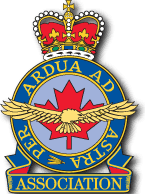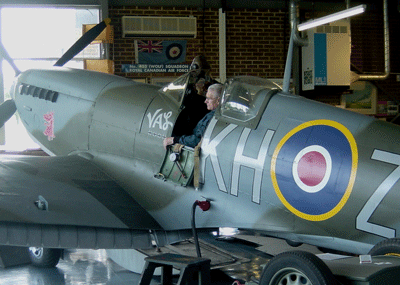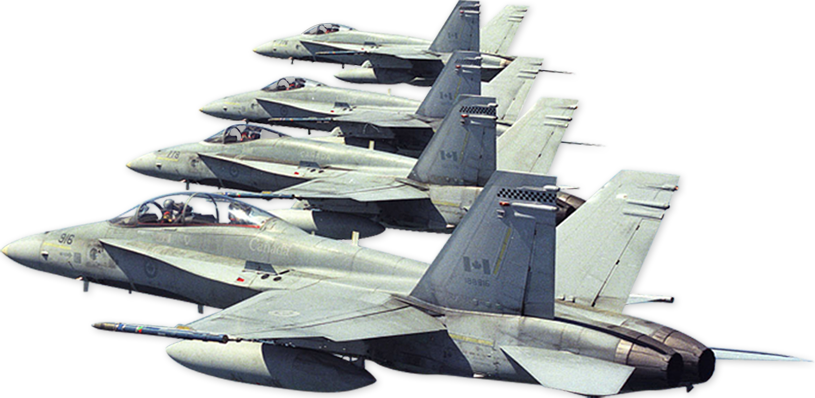Pilot Officer (Retired) Stephen Butte, DFC, P.Eng., hcol
An Honourable Journey
Steve Butte, DFC, BSc, PEng
by Dean Black
A legendary life has come to an end. Steve Butte passed away on Remembrance Day, 2010, near Perth, Australia. The name might not be familiar, but Steve is a Canadian veteran worth knowing.
The year 1944 ended relatively quietly for Pilot Officer Butte. Like many fighter pilots, Steve preferred being alert while at the controls. A Spitfire was hard enough to handle sober; a fuzzy head at altitude was the same as a foot in the grave. Anticipating an early morning launch, Butte steered clear of any big New Year?s Eve celebrations, choosing instead to down a couple of glasses of kummel before getting some shut-eye. Of course, he had no inkling of what was in store for him the following day.
Steve Butte had joined the ranks of 403 (Wolf) Sqn at Tangmere in southern England on Saturday, June 10th 1944. He and another pilot, Ron Forsyth, reported to the squadron in good spirits. They were joined by Ken ?Red? Harvey who joked he was going to enjoy working in 403, because all the squadron?s Spitfires sported his initials (KH)!
Steve Butte was born in Waugh, Alta in November 1923. He graduated from high school in Michel, BC, in 1941 and then tried to join the RCAF. ?The recruiting officer told me to come back after I turned 18,? he recalled. ?When the time was right, I signed up and then underwent initial training in Belleville, Ont, elementary flying training at St Eugene, Ont and service flying at Camp Borden, Ont.? With initial training behind him he sailed for England in March of 1943 to undergo operational and gunnery training.
On June 16th, 10 days after D-Day, 403 Sqn deployed to airfield B2 in Bazenville, Normandy. His first assignment saw him flying as No. 2 to F/L Andy MacKenzie. Andy quickly befriended Steve and years later would often claim he felt as ?safe as a church? with Steve on his wing.
Things were quiet for some time. To keep busy, Steve Butte recalls conducting something for which Spitfires were not ideally equipped ? armed reconnaissance. ?The aircraft were susceptible to damage to the air cleaner while low-flying,? he said. One day in July 1944 while on patrol, Steve?s flight discovered what appeared to be German fuel bowsers ? big tanker trucks ? hiding in the woods. ?I think I?ve spotted something big down there,? he called to his wingmen soon after catching a reflection. He ordered the others to follow him down. The flight circled around and, like Steve, dove in at the bushes where Steve had been directing his cannon fire. Together, the Spitfires wiped out a number of the huge bowsers ? leaving a towering plume of smoke and flame blasting to great heights as the Spitfires dashed away at tree-top level.
Back in the bar his fellow pilots mused about how Panzer tanks near Caen had probably been waiting for that fuel because they couldn?t travel during the day due to the danger of air attack.
Steve Butte recalls that towards the end of the war he was somewhat alarmed the day he encountered a number of German Me-262 jet fighters ? one of Hitler?s new secret weapons. But he also remembered how they could be terrifying to those on the ground. ?They would fly at 30,000 feet so no one knew they were up there,? he explained. ?All of a sudden one would hear a ?poof? meaning that you had about seven seconds to find cover because the 262 had just dropped an anti-personnel mine which would scatter up to 69 softball-sized bomblets at 1,000 feet which, upon hitting the ground would explode.? One day the squadron padre was sitting in the latrine when he heard the ?poof.? The padre considered his options, but only for a millisecond. He quickly jumped into the pit and lived to tell his unsavoury story.
One cloudy day, Butte was up on a reconnaissance flight over Aachen, Germany and encountered three Me-262s. His flight of 403 Sqn Spitfires was being led by the commanding officer, S/L Jim Collier. They were underneath the 262s that were in a right-hand turn. Steve and Jim engaged the enemy aircraft. Afterwards, Collier claimed the kill, explaining that the enemy pilot had bailed out and the aircraft crashed. However, Steve?s gun-camera clearly showed that he was still firing at the 262 before and while the pilot was trying to exit the aircraft. As many as four more kills were shared this way, because it was so difficult to prove who should receive full credit.
On the New Year?s morning of 1945 mentioned earlier, Steve Butte?s wing commander, W/C James Edgar ?Johnnie? Johnson was having breakfast with G/C William ?Iron Bill? MacBrien when approximately 40 enemy aircraft attacked their airfield at Evere, Belgium. Steve and his wingman had been scheduled for a patrol and weather-check. Minutes earlier, fellow flyers Dick Reeves and ?Mac? Reeves (no relation) had launched for a similar patrol. That section reported the runway usable, so Steve Butte and Keith Lindsay started their aircraft. Just as they got airborne a few minutes before 9:00 am, the enemy force attacked. Steve tried to shake-loose his auxiliary fuel tank? to no avail. It was just as well since he later recalled being directly over the entranceway to the Officers? Mess. Johnson and MacBrien were standing at the entranceway to see what all the commotion was about.
Before he could raise his landing gear, Butte had managed to shoot one of the attackers down. He continued to spray the formation of enemy aircraft, while he raised his landing gear, downing two more before running out of ammunition. Jim Collier recognized Steve for his courage by writing a recommendation for a Distinguished Flying Cross (DFC) on Jan 20th. By Jan 29th word had come back confirming the award.
It was a painting of the action that New Year?s morning 1945 that brought the memory back to Steve Butte. That day, war-artist Don Anderson, was enjoying the post-New Year?s Eve celebration walking down Sabina Street near Evere. ?The Americans are flying funny today,? Anderson quipped. Then he realized they weren?t Americans at all. The black Maltese crosses painted on the aircraft convinced him that something was not right. He hurried back to the airfield, only minutes away, but by then the action was all but over. He estimates about 40 enemy fighters had attacked. He witnessed a section of Spitfires returning to the airfield, and began to sketch the scene. The pilots, he assumed, had seen the smoke from the attack, and were returning to join the donnybrook. The lead aircraft turned out to be flown by Steve Butte. ?Steve,? Don Anderson recounted, ?downed two of the enemy and some of the wreckage littered the very street I had been walking down moments earlier.
On March 10th 1945 Steve Butte?s tour of operations ended. Upon repatriation to Canada he applied to the University of BC, to take up civil engineering, graduating in 1952. He married the former Marie Smith from Truro, NS. Lieutenant Smith had served as a Canadian Army nursing sister at Bramshot Military Hospital in London. After the war she worked in Vancouver and was personally chosen by Dr Ross Robertson, a pioneer in pediatrics who helped develop successful medical procedures for ?blue babies.? Sadly, Marie passed away in 1974.
Steve Butte’s first engineering assignment was to the Kemano Powerhouse Project in British Columbia. Alcan, the aluminum corporate giant, was building a huge smelter for which they needed power, and the Nichako-Kitimat Project was initiated, of which Kemano was a part. The end result was the availability of two million, two hundred and forty-thousand horsepower of hydro-electricity for the production of aluminum.
Steve Butte worked for nine-years in the power phase of this project before transferring to the smelter phase. During the process he contributed to the building of a city for 14,000 people in Kitimat. He built an 80-kilometer transmission line using some of the largest conductors in the world. Thereafter he was employed with Alcan as a field engineer for nine years. He was the resident civil engineer on the Mica Dam project from 1961 to 1966. In the same capacity, he also worked on the Aishihik Project in the Yukon. This project called for another dam and underground powerhouse.
Steve Butte finally retired from engineering in 1974, the year his wife died. Relishing the backwoods lifestyle, he kept himself busy by mining for gold in the Hixon area of BC and raising donkeys and llamas. His tiny log cabin, 12-km east of Hixon, was protected by stray dogs which friends from the village would leave him, to help fend off the bears.
In 2000 Steve decided to settle with his daughter Marlene, in Bedford, NS. The work he had done with the local Legion in branches near Revelstoke and Dawson Creek back in BC encouraged him to reacquaint himself with similar groups in Halifax. He soon became affiliated with the Air Crew Association on the East Coast where he learned of the upcoming 60th anniversary celebrations scheduled for July 2001 at 403 (Helicopter) Operational Training Sqn, CFB Gagetown, NB.
As the incumbent commanding officer of 403 Sqn, I was ?over the moon? when I learned that two Spitfire veterans had chosen to join us for the celebrations ? Steve Butte and Aurel ?Amigo? Roy. Steve showed tremendous interest in the squadron and both he and Aurel were well-received by squadron personnel. We realized that a tremendous opportunity had presented itself; our honorary colonel, James Stewart, DFC was ready to step down after having served three years in that capacity. This left the door open for us to seek someone who had served with 403 Sqn during the war. Art Eggleton, minister of national defence, and Col Marcel Duval, the commander of 1 Wing, approved our nomination and Steve was invested during a very respectable ceremony in April 2002 followed by a formal mess dinner held at the Lord Beaverbrook Hotel in nearby Fredericton. Capping off the night, squadron personnel were invited to meet Steve Butte while he autographed print reproductions of Don Anderson?s wartime watercolour depicting the scene at Evere minutes after the 1945 Operation Bodenplatte raid when Steve earned his DFC. Steve was not aware the painting existed, but had no difficulty recognizing that he could be the only possible pilot flying the lead Spitfire depicted in the painting.
In May 2002, Air Command granted me permission to travel to the Spitfire Museum at RAF Manston near Ramsgate, England along with our new honorary colonel. Local authorities had been planning a tree-planting ceremony honouring 403 Sqn personnel who had perished during the war. Honorary Colonel Steve Butte?s presence was the icing on the cake. The museum?s curator invited Steve to climb into their 403 Sqn Spitfire ? KH-Z ? TB752 where he spent almost an hour in the cockpit, leading me to fear we might not ever get him out. It was the first time in over 55 years he had been inside one of the iconic fighters.
On our last night before leaving England Steve asked if I could take him to Trafalgar Square in London. It became clear to me shortly after our arrival that he was reaching back to a time that for him carried great personal meaning. His wartime service, while brief, defined him in his earliest days. He had lost his father when he was only five-years-old, then his wife. Between these tragedies Steve?s service in the RCAF, culminating in his receipt of a DFC, underscored the courageous man he had obviously become. It is difficult for those of us who have not been through similar circumstances to understand how profound the impact of wartime service was on men and women of that generation.
Steve Butte and I wandered around Trafalgar Square for a while before he admitted he wanted to take a piece of it home. I managed to kick loose a small corner of the sidewalk, and it quickly disappeared into his pocket. I have often wondered if that small piece of concrete might have been worth more to him than any of the gold he might have found near Hixon, BC.
Before I relinquished command of 403 Sqn, I asked Steve if he would consider a posthumous honour for his former wing commander, Johnnie Johnson. I explained to Steve that Johnnie had been wing commander (flying) to the squadron in the days leading up to the Dieppe Raid of 1942. So impressed with Johnson were the Canadians that their commanding officer, S/L Syd Ford marched unannounced into Johnson?s office one day and tossed a couple of ?Canada? flashes onto his desk. ?The boys want you to wear these,? Ford explained. Johnson was visibly moved by the unusual vote of confidence. Despite the fact he was an RAF officer, he would not take the flashes down for the next two years. This story was enough for Steve to agree to my request seeking a posthumous appointment of Air Vice-Marshal James Edgar ?Johnnie? Johnson, CB, CBE, DSO, DFC as honorary group captain of 403 Sqn. Steve presented the idea to Paul Burden, DFC, James Stewart, DFC, and retired Col Ralph Annis, CD ? his predecessors ? and they supported the idea. During the formal ceremony the squadron?s boardroom at CFB Gagetown was also named after Johnnie Johnson. Final approval for these honours came from Johnson?s two sons, Chris and Michael, who responded to our letter which had been written on the anniversary of their father?s 2001 passing.
When I reflect on these events I realize I have been blessed with a rare privilege. Meeting a veteran is itself a unique opportunity; winning their trust such that they share their stories is something special indeed. But I have struggled to understand the message underpinning Steve?s life. I finally understood what that message was, when Steve explained that not all fighter pilots were the same. Without exception, he explained, one could not help but be proud of those who mounted their aircraft each and every sortie. However, when the time came, a very small number would find some way to avoid a fight. Steve emphasized this point by saying, in this respect Johnnie Johnson was the greatest of leaders. Like Andy MacKenzie and others, Johnson would ?get into it? without hesitation. Steve Butte learned from these mentors; he jumped in with both feet each and every time. It was this element of courage that defined some, placing them head-and-shoulders above the few who could not for whatever reason muster the strength. Perhaps the words of Mark K. Wells, author of Courage and Air Warfare, said it best: ?…the correct blend of practical leadership characteristics demonstrated what was universally known as ?guts.? At the operational and tactical level of air combat, courage ? and tenacity ? often outweighed pure intellectual abilities?.
I now realize that ?guts? defined Steve Butte; this was especially the case on the morning of Jan 1st 1945. His only regret was not being more judicious with his ammunition. ?I think I just pressed the triggers and never let go,? he admitted. The main point is he didn?t run; he fired and kicked the hell out of his rudder to take out as many enemy aircraft as possible.
After the war the enormity of Steve Butte?s engineering projects speaks to a special kind of courage and tenacity. He literally moved earth and sky bringing power to British Columbia, fulfilling his wide-ranging duties with the same kind of determination that brought him great credit during the war. He truly is a remarkable Canadian, well worth getting to know.
At his most generous request I traveled to Perth, Australia, in early December 2009, to meet up with Steve once again. We spent a week together, before I had to return to Canada. His daughter revealed to me that Steve was not well, and wanted to reach out to those who, according to Steve “made a difference in his life”. Steve left behind?a wonderful woman ? Rona.?To Steve, we extend?thanks from today?s air force for setting a great example for all Canadians.
Steve Butte strapped himself into Spitfire KH-Z, during a visit to the Ramsgate, Manston, Kent Hurricane-Spitfire Museum in May?2002, and for the next hour told all of us how well the aircraft served him 60-years earlier.








